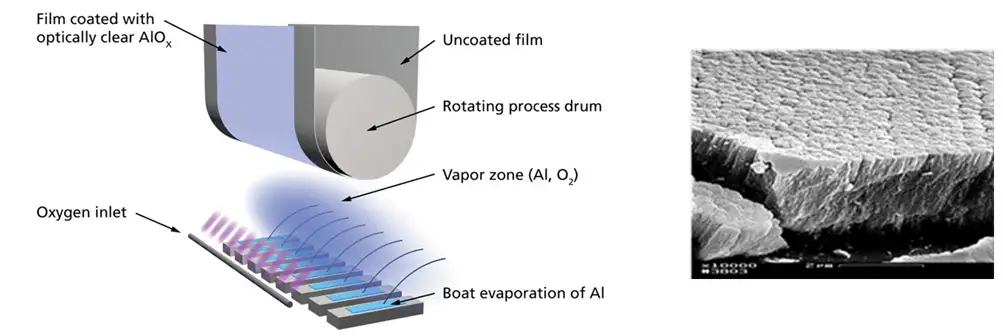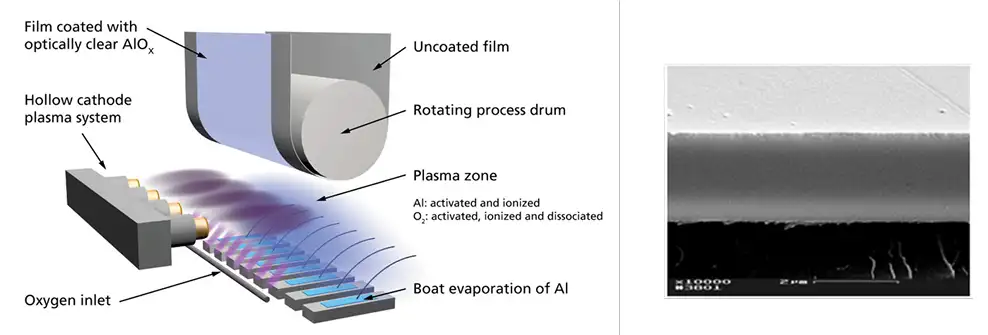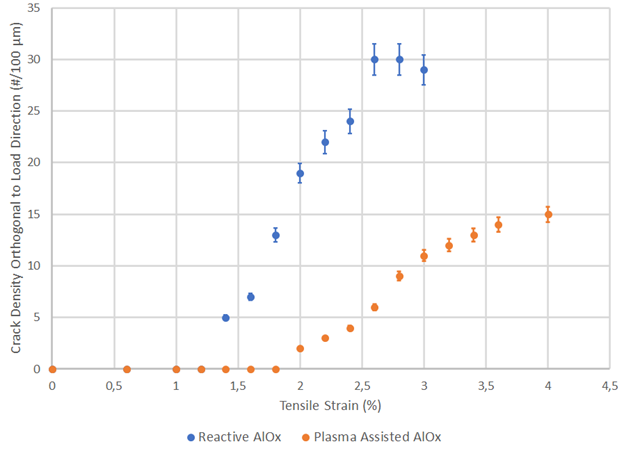
By N.A. Morrison, chief technologist; M. Campo, technical staff member; T. Crouch, head of packaging; R. Verghese, R&D mgr.-Flexible Products Group, Applied Materials Web Coating GmbH; and S. Straach, group mgr., Fraunhofer FEP
AlOx has long been touted as a suitable transparent layer for packaging applications and indeed has found use in a range of retort applications based on high-performance PET substrates. However, the drive toward sustainable-packaging solutions using a polyolefin “mono-material” architecture has resulted in an increased desire to use softer, reduced-stiffness substrate materials. Standard reactive evaporation of these AlOx thin films no longer can be used to deposit high-quality, mechanically resilient coatings capable of surviving downstream converting at high yield. Alternative substrate-engineering techniques and/or AlOx-deposition technologies therefore are required to compensate for these effects. This paper describes the use of an engineered-BOPP substrate in combination with a high-density, plasma-assisted, AlOx-deposition technique and focuses on the fundamental differences in mechanical and resultant barrier performance achievable with both the standard reactive deposition and plasma-assisted deposition approaches. Conclusions also are provided indicating the inherent suitability of the plasma-assisted approach for high-yield, high-performance, transparent-barrier solutions required for the next generation of sustainable flexible packaging.
Editor’s Note: This technical paper is based on the authors’ presentation at the 2022 AIMCAL R2R Europe Conference held June 7-9, 2022, in Valencia, Spain.
Introduction
Vacuum-deposition technologies have been used in the high-volume manufacture of barrier films for food packaging for over 60 years. This typically has involved the high-rate evaporation of thin aluminum layers onto polyethylene terephthalate (PET), polypropylene (BOPP & CPP), or polyethylene (PE) substrates. However, the recent trend toward recyclable packaging and the circular economy has focused efforts on the commercialization of transparent-barrier technologies, particularly for applications where product viewing, X-ray screening and microwaveability are of importance [1]. Thin ceramic-like layers, such as AlOx and SiOx deposited on polyolefin-based substrates (BOPP, CPP & PE), therefore are used to provide solutions that satisfy current packaging mono-material requirements (<5% difference in composition by volume).
These thin ceramic-like layers all can be deposited using high-rate, low-cost evaporative techniques. However, the nature of the evaporation process and the type of inorganic system used must be matched to the intrinsic mechanical properties of the specific substrate used. This paper will, therefore, focus on describing the mechanical behavior exhibited by two different types of AlOx deposited on a biaxially oriented polypropylene (BOPP) substrate incorporating an EVOH skin layer and provide insight into the underlying mechanisms controlling the resultant coating robustness relevant for the downstream converting process.
AlOx deposition technologies and their intrinsic layer properties
Conventional AlOx for packaging can be deposited using an array of resistively heated boats. Aluminum wire is fed to the boat surface, using a stepper motor, where it is allowed to melt prior to evaporation. Oxygen gas typically is introduced to the process environment via a multiplicity of gas lances placed orthogonal to the transport direction of the roll-based substrate (see Figure 1).

The oxygen gas is activated purely by the energy supplied from the reactive Al plume, and an AlOx layer condenses on the surface of the substrate transported over a cooled, rotating process drum. Due to the low energy of the growth flux (<0.2 eV), there is little opportunity to enhance the deposited-material density, microstructure, transparency and, ultimately, barrier performance. However, the technology is inexpensive and easy to scale.
A more elegant approach employs an additional array of hollow-cathode-based plasma sources to provide a highly dissociated and energetic growth flux during deposition (see Figure 2). This plasma-assisted technology, known as HAD, permits the deposition of optically clear, dense and grain-boundary-free AlOx at production-worthy speeds and costs [2].

Such an energetic (10-20eV) plasma-assisted approach results in a significant improvement in layer density. Standard reactive AlOx materials have densities of approximately 2.4 g/cm3, increasing by around 20% to 3.0 g/cm3 for the plasma-assisted material. This performance improvement, coupled with the concomitant reduction in intrinsic defect density, results in an AlOx layer capable of surviving robust handling during downstream processing & conversion methods even in the absence of a protective organic topcoat.

Mechanical characteristics and crack behavior under tensile loading
Ceramic materials are strong in compression but very weak under tension. These effects are exacerbated for layers deposited on much softer substrate materials, accounting for much of the mechanical failure observed under tensile-loading conditions. This behavior can best be quantified through use of fragmentation testing and involves the application of a known stress and resultant strain to the coated substrate and the microscopic detection of the cracking process as shown in Figure 3 [3-11]. The resultant crack-density data can be used to extract the AlOx layer’s tensile strength; crack onset strain; fracture energy-release rate; fracture toughness; Weibull modulus and shape factor; and ultimately, the probability of the layer’s failure, the results of which are shown in Table 1.

The crack density data obtained from both standard-reactive and high-density, plasma-assisted AlOx deposited on an EVOH-skinned BOPP substrate is shown in Figure 4. The results clearly demonstrate an increase in robustness of the plasma-assisted material relative to the standard-reactive AlOx. The critical stress and strain levels are >40% higher for the plasma-assisted layer, and this is coupled with a 50% lower crack density under crack-saturation conditions. This generic behavior also is mimicked by the barrier performance with an observed inflection in measured barrier within ±0.2% of the crack onset strains observed via fragmentation testing. The magnitude of the barrier performance degradation also correlates well with the increase in open crack area.

Significant differences in fracture energy-release rate, fracture toughness and coating tensile strength were observed between the two AlOx types, contributing substantially to the measured increase in crack onset strain level for the plasma-assisted material (see Table 1). Additional improvements in elastic & Weibull moduli and the Weibull shape parameter also were observed, ultimately impacting the fracture probability under tensile loading. In addition, the fracture energy-release rate is strongly dependent on the quality of the interface between the AlOx layer and substrate. The additional “pre-treatment effect,” provided by the plasma-assisted process during the early stages of layer nucleation and growth, results in a near 25-fold increase in measured fracture energy-release rate. The net result of this increase is an increase in crack onset strain level relative to that measured for the standard-reactive AlOx.
Part 2 of this technical paper will cover useful equations, WVTR barrier improvements, differences with various packaging substrates and the impact of layer performance on secondary converting.
References
- N. Morrison, R. Ludwig, G. Hoffmann, C. Kurthen & P. Olbrich, Coating International, 50, 34 (2017).
- S. Günther, S. Straach, N. Schiller, A. L. Quiceno, A. G. Contreras, R. Ludwig & G. Hoffman, Proceedings of the 52nd Annual Technical Conference of the Society of Vacuum Coaters, 727(2009).
- A. Pinyol, B. Meylan, D. Gillieron, V. Mewani, Y. Letterier & J.A.E. Manson, Thin Solid Films, 517, 2000 (2009).
- Y. Letterier, Progress in Materials Science, 48, 1 (2003).
- Y. Letterier, D. Pellaton, D. Mendels & R. Glauser, Journal of Materials Science, 36, 2213 (2001).
- Y. Letterier, L Medico, F. Demarco, J.A.E. Manson, U. Betz, M.F. Escola, M. Kharazzi Olsson & F. Atamny, Thin Solid Films, 460, 156 (2004).
- Y. Letterier, L. Boogh, J. Andersons & J.A.E. Manson, J. Polym. Sci. B: Polym. Phys., 1449 (1998).
- Y. Letterier, J. Andersons, Y. Pitton & J.A.E. Manson, J. Polym. Sci. B: Polym. Phys., 1463 (1998).
- M. Ruoho, J.P. Niemela, C. Guerra-Nunez, N. Tarasiuk, G. Robertson, A. Taylor, X. Maeder, C. Kapusta, J. Michler & I. Utke, Nanomaterials, 10, 558 (2020).
- M.V. Taveres de Costa & E.K Gamstedt, Engineering Fracture Mechanics, 235, 107151 (2020).
- M.V. Taveres de Costa , J. Bolinsson, R. Cristian Neagu, Pierre Fayet & E.K Gamstedt, Surface & Coatings Technology, 370, 374 (2019).

Neil Morrison is Chief Technologist for R2R processing at Applied Materials’ Technology Centre (Alzenau, Germany) and is responsible for defining Applied’s R&D strategy for programs for barrier films, substrate and cover-glass hardcoats, touch panels and flexible electronic devices, in addition to evaporation processes for the food packaging, securities & battery industries. The majority of this work has been based upon the development of both R2R PVD, PECVD, dry etch and lithography hardware & process development for the deposition of device-quality materials. He was awarded a Ph.D. in Plasma & Materials Chemistry from Heriot-Watt University in Edinburgh (Scotland) and spent seven years as a member of both research & teaching staff within the Engineering Department at the University of Cambridge in the UK. Neil can be reached at +49-6023-92-6094, neil_morrison@amat.com, www.appliedmaterials.com.

Manuel Campo is a member of the technical staff in R2R processing at Applied Materials’ Technology Centre. He has a graduate diploma & Ph.D. in Plasma Chemistry & Photovoltaics from the Johan Wolfgang Goethe University in Frankfurt, Germany. Manuel has been working in various process-engineering roles for Applied Materials since 2003 and focused on large-area, thin-film deposition using evaporation, sputtering and PECVD for a broad variety of applications, including OLED lighting and display, thin-film encapsulation, photovoltaics, thin-film battery and, most recently, sustainable packaging. He can be reached at manuel_campo@amat.com.

Tarquin Crouch is Head of Packaging for Applied Materials’ R2R business. He is responsible for product strategy and business development. Tarquin leads a small team involved in proving equipment capability and value-chain activities while maintaining an overview of the market, film developments and the response to sustainability. He holds a Master of Science in Packaging Technology, and the majority of his working life has been spent in a variety of roles in film sales and development with PET and BOPP manufacturers but with a few years in polymer additives and plastic recycling. Tarquin can be reached at tarquin_crouch@amat.com.

Raj Verghese is the R&D Manager for the Flexible Products Group at Applied Materials, based in North America. His focus is on developing new technologies/applications in the R2R flexible-packaging market. He has extensive experience in metallized base-film development and operational experience in film manufacturing. Raj holds a Bachelor of Science in Chemical Engineering from Drexel University, Philadelphia, PA. He can be reached at rajan_verghese@amat.com.

Steffen Straach is one of the project and group managers within the R2R technologies department at the Fraunhofer Institute for Organic Electronics, Electron Beam and Plasma Technology FEP in Dresden, Germany. He has been working for more than 25 years on several projects to develop vacuum R2R-deposition technologies and to transfer these technologies to industrial partners. He has a graduate diploma in Electrical Engineering and Microelectronics from the Technical University in Dresden. Steffen can be reached at Steffen.Straach@fep.fraunhofer.de.

